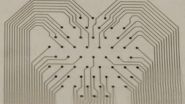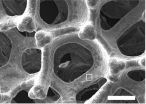(Press-News.org) A research team led by Northwestern University nanomedicine expert Chad A. Mirkin and Sergei Gryaznov of AuraSense Therapeutics is the first to show spherical nucleic acids (SNAs) can be used as potent drugs to effectively train the immune system to fight disease, by either boosting or dampening the immune response. The initial treatment triggers a cell-specific immune response all over the body.
By increasing the body's immune response toward a specific cell type, SNAs could be used to target anything from influenza to different forms of cancer. They also can be used to suppress the immune response, a tactic important in treating autoimmune disorders, such as rheumatoid arthritis and psoriasis, where the body's immune system mistakenly attacks healthy tissues.
"The ability to selectively trigger the immune response with spherical nucleic acids presents a whole new way of thinking about drug development," said Mirkin, a corresponding author of the study. "Once developed fully, SNAs will lay the foundation for developing an entire new pipeline of drugs to treat a range of diseases, from psoriasis, lupus and rheumatoid arthritis to lymphoma, bladder cancer and prostate cancer."
Mirkin is the George B. Rathmann Professor of Chemistry in the Weinberg College of Arts and Sciences and professor of medicine, chemical and biological engineering, biomedical engineering and materials science and engineering.
The study also shows that a spherical structure is the ideal architecture for delivering nucleic acids into cells for therapeutic purposes. The spherical arrangement of approximately 100 DNA strands attached to a benign nanoparticle core made of lipid or gold significantly outperformed nucleic acids in linear form.
The advantages of spherical nucleic acids in targeting the immune system include:
SNAs are nontoxic. Cells take them up naturally without the conventional need for a secondary agent, which can result in toxicity.
SNAs naturally go to the right place in cells. They enter via the endosome, a compartment where the immune system's toll-like receptors (TLRs) are located. The TLRs are the controls of the immune system.
SNAs are very potent. The single-stranded DNA on the nanoparticle core can be ideally positioned and oriented to specifically and fully interact with the targeted toll-like receptors. (Linear nucleic acids are delivered in random form and, therefore, do not engage the TLRs as effectively.)
The study will be published the week of March 16 by the Proceedings of the National Academy of Sciences (PNAS).
Mirkin and his colleagues tested their SNAs head to head with known linear nucleic acids, targeting lymphoma and a form of autoimmune hepatitis. "The spherical nucleic acids always win from potency and speed standpoints, which corresponds with our understanding of their pathway of cellular entry," Mirkin said.
The researchers design SNAs for individual targets. Different DNA sequences are used to engage specific toll-like receptors, which result in either a stimulation or suppression of the immune response, depending on what the goal is.
When an SNA with its nucleic acid shell approaches a cell, it is engulfed in the form of an endosome and taken inside the cell. Once in the endosome, the DNA strands of the SNA interact with toll-like receptor proteins (TLRs). The signaling of TLRs plays an essential role in the innate immune response.
In a study of mice, the researchers tested SNAs against lymphoma. For the animals treated with SNAs, the researchers found a significant decrease in tumor growth and a doubling of lifespan. The potency was up to an 80-fold increase over linear nucleic acids of the same sequence. In this case, SNAs trained the immune system to seek out and destroy lymphoma cells.
Next, focusing on nonalcoholic steatohepatitis (NASH), the researchers found eightfold increases in potency when animals were treated with SNAs and a 30 percent greater reduction in the animals' fibrosis score. This observation has significant implications for treating liver cancer and cirrhosis patients.
"The beauty of the approach is that a very small amount of drug does a tremendous amount of work," Mirkin said. "The SNAs trigger the immune response and, without more drug, additional cells are trained to behave the same way as the initial cells. This gives you a catalytic effect that grows into a systemic search for cells that look, for example, like lymphoma cells."
Mirkin invented SNAs, new spherical forms of DNA and RNA, at Northwestern in 1996. SNAs are nontoxic to humans, making them a versatile tool in medicine.
The current study's results show, Mirkin said, that if you want to make vaccines out of nucleic acids or if you want to modulate the immune system using nucleic acids, for vaccines or systemic suppression therapies, then the spherical nucleic acid architecture is likely the most potent.
INFORMATION:
The title of the paper is "Immunomodulatory Spherical Nucleic Acids."
In addition to Mirkin and Gryaznov, other authors of the paper are Natalia Chernyak (co-first author) and Timothy J. Merkel, from Northwestern, and Aleksandar F. Radovic-Moreno (co-first author), Christopher C. Mader, Subbarao Nallagatla, Richard Kang, Liangliang Hao, David A. Walker, Tiffany L. Halo, Clayton Rische, Sagar Anantatmula and Merideth Burkhart, from AuraSense Therapeutics, LLC.
Editor's note: Chad Mirkin and Sergeu Gryaznov have interest in AuraSense Therapeutics, a startup biotechnology company that is commercializing spherical nucleic acid-based therapeutics and licensed the SNA technology from Northwestern University. Mirkin is a co-founder of the company.
New heart imaging technology to diagnose coronary heart disease and other heart disorders is significantly more accurate, less expensive and safer than traditional methods, according to a new study by researchers from the Intermountain Medical Center Heart Institute in Salt Lake City.
Researchers at the Intermountain Medical Center Heart Institute compared Single Photon Emission Computed Tomography (SPECT), currently the most commonly used imaging diagnostic tool, with a new imaging technology -- coronary-specific Positron Emission Tomography (cardiac PET/CT).
They ...
A recently published global genome study that used the data-intensive Gordon supercomputer at the San Diego Supercomputer at the University of California, San Diego, has researchers rethinking how avian lineages diverged after the extinction of the dinosaurs.
The four-year project, called the Avian Genome Consortium and published in the journal Science, resulted in a new family "tree" for nearly all of the 10,000 species of birds alive today by comparing the entire DNA codes (genomes) of 48 species as varied as parrot, penguin, downy woodpecker, and Anna's hummingbird. ...
SAN DIEGO (March 16, 2015) -- Patients who experience the deadliest form of heart attack--ST segment elevation myocardial infarction (STEMI)--and suffer from substantial narrowing in multiple heart arteries may benefit from receiving angioplasty in constricted arteries not affected by the heart attack, thereby reducing the need for future angioplasty, according to research presented at the American College of Cardiology's 64th Annual Scientific Session.
The study is the largest prospective, controlled trial to evaluate whether patients should receive preventive angioplasty, ...
OAKLAND, Calif. -- Specific system-level factors controlled by health care systems - including prescriptions with a medication supply greater than 90 days, mail-order pharmacy use, and lower copayments and out-of-pocket maximums - nearly doubled the likelihood that patients adhered to prescribed heart and diabetes medications, according to a new study published in the journal Medical Care.
"This study is the first to look at all four of these system-level factors at once in the senior population," said Julie A. Schmittdiel, PhD, research scientist with the Kaiser Permanente ...
If you're a fan of food television, it's fine to be entertained by the programming, but if you take recipes for the rich meals the networks favor into your own kitchen, you're at risk of putting on pounds, according to a study just published online by the journal Appetite.
"The message is clear," said Lizzy Pope of the University of Vermont, the study's lead author. "Food TV should be a viewing experience only, not a cooking experience."
The study asked 501 women, aged 20 to 35, where they obtained information about new foods, how frequently they cooked from scratch, ...
Healthy bone is continuously involved in a dynamic process that includes bone deposition and bone resorption. However, when a person has cancer that spreads to the bone and bone marrow, the tissue becomes increasingly fragile, and this process is disrupted, usually leading to increased bone resorption.
In an early online edition in advance of publication in the International Journal of Cancer, investigators at Children's Hospital Los Angeles reported a surprising discovery - when neuroblastoma (NB) cells metastasize to the bone, there initially occurs an increase in bone ...
Berkeley -- Engineers at the University of California, Berkeley, are developing a new type of bandage that does far more than stanch the bleeding from a paper cut or scraped knee. Thanks to advances in flexible electronics, the researchers, in collaboration with colleagues at UC San Francisco, have created a new "smart bandage" that uses electrical currents to detect early tissue damage from pressure ulcers, or bedsores, before they can be seen by human eyes - and while recovery is still possible.
"We set out to create a type of bandage that could detect bedsores as ...
UNSW Australia scientists have developed a highly efficient oxygen-producing electrode for splitting water that has the potential to be scaled up for industrial production of the clean energy fuel, hydrogen. The new technology is based on an inexpensive, specially coated foam material that lets the bubbles of oxygen escape quickly.
"Our electrode is the most efficient oxygen-producing electrode in alkaline electrolytes reported to date, to the best of our knowledge," says Associate Professor Chuan Zhao, of the UNSW School of Chemistry.
"It is inexpensive, sturdy and simple ...
Tuesday, March 17, 2015. Just like milk and many other foods, blood used for transfusions is perishable. But contrary to popular belief, new research shows that blood stored for three weeks is just as good as fresh blood - findings published today in the New England Journal of Medicine.
The large clinical trial provides reassuring evidence about the safety of blood routinely transfused to critically ill patients. Supported by the Canadian Critical Care Trials Group and countless nurses, blood bank technologists, transfusion medicine and critical care physicians, Drs. ...
Ann Arbor, MI, March 17, 2015 -- Suicide is responsible for more than 36,000 deaths in the United States and nearly 1 million deaths worldwide annually. In 2009, suicides surpassed motor vehicle crashes as the leading cause of death by injury in the U.S. A new study published in the American Journal of Preventive Medicine analyzes the upward trend of suicides that take place in the workplace and identifies specific occupations in which individuals are at higher risk. The highest workplace suicide rate is in protective services occupations (5.3 per 1 million), more than ...


